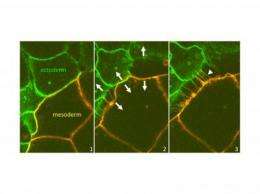Repulsion more important than cohesion in embryonic tissue separation

Until now, adherence was thought to be the principle force responsible for the separation of the ectoderm from the mesoderm in embryonic cells. But by using high resolution imaging, researchers have now discovered that, although embryonic cells of different types will temporarily adhere when they touch, they then invariably pull apart rather violently, suggesting that direct contact between two "foreign" cells triggers a "repulsive signal."
As our bodies form, cells within the embryo divide and separate. Certain cells come together to form the outer layer, or ectoderm, of the early embryo, and give rise to tissue such as the skin and nervous system (spine, peripheral nerves and brain). Other cells come together to form the mesoderm or middle layer of the embryo, and eventually give rise to tissue like muscle, heart or bone. Once cells have been assigned to the different regions – mesoderm or ectoderm – a mysterious mechanism draws boundaries between them that mark their permanent separation. Any defect in these boundaries leads to disorganized mixing of cell populations, severe embryo abnormalities and eventually lethality.
Until now, adherence was thought to be the principle force responsible for the separation of the ectoderm from the mesoderm in embryonic cells. The Differential Adhesion Hypothesis used to explain the process of embryonic tissue separation – which has been accepted until now – postulates that cells from each population stick together better than to cells from the other population due to the composition and properties of adhesion molecules expressed at their surface.
But François Fagotto, a McGill biologist, working in collaboration with Rudi Winklbauer from the University of Toronto, had a closer look at what really happens at these boundaries using high-resolution live imaging. They discovered that, although embryonic cells of different types will temporarily adhere when they touch, they then invariably pull apart rather violently, suggesting that direct contact between two "foreign" cells triggers a "repulsive signal".
This cycle of adhesion followed by repulsion is reminiscent of what happens in the brain, where nerve cells must follow precise paths and are guided along these paths by repulsive clues. Fagotto and Winklbauer have discovered that certain proteins expressed at the cell surface, the ephrins and Eph receptors, which are known to be responsible for both triggering this repulsion in nerve cells and creating boundaries in certain regions of the brain, are also at work in embryonic tissue separation.
"The ectoderm-mesoderm boundary is a very early and basic separation in the embryo. Historically it was at the origin of the Differential Adhesion Hypothesis," says Fagotto. "It is tempting to generalize form our results and suggest that tissue formation may not depend so much on the set of adhesion molecules, but rather on the set of repulsive cues expressed by each cell type."
More information: www.plosbiology.org/article/info%3Adoi%2F10.1371%2Fjournal.pbio.1000597
Provided by McGill University
















